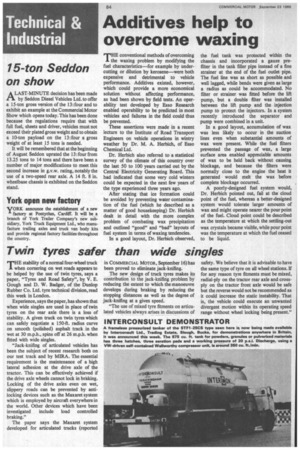Additives help to overcome waxing
Page 86

If you've noticed an error in this article please click here to report it so we can fix it.
THE conventional methods of overcoming the waxing problem by modifying the fuel characteristics—for example by undercutting or dilution by kerosene—were both expensive and detrimental to vehicle performance. Additives existed, however, which could provide a more economical solution without affecting performance, as had been shown by field tests. An operability test developed by Esso Research enabled operability to be predicted in most vehicles and failures in the field could thus be prevented.
These assertions were made in a recent lecture to the Institute of Road Transport Engineers on vehicle operations in wintry weather by Dr. M. A. Herbich, of Esso Chemical Ltd.
Dr. Herbich also referred to a statistical survey of the climate of this country over the last 50 to 100 years carried out by the Central Electricity Generating Board. This had indicated that some very cold winters could be expected in the next few years of the type experienced three years ago.
After stating that ice formation could be avoided by preventing water contamination of the fuel (which he described as a matter of good housekeeping) Dr. Herbich dealt in detail with the more complex problem of combating wax precipitation and outlined "good" and "bad" layouts of fuel system in terms of waxing tendencies.
In a good layout, Dr. Herbich observed, the fuel tank was protected within the chassis and incorporated a gauze prefilter in the tank filler pipe instead of a fine strainer at the end of the fuel outlet pipe. The fuel line was as short as possible and well lagged, while bends were given as large a radius as could be accommodated. No filter or strainer was fitted before the Lift pump, but a double filter was installed between the lift pump and the injection pump to protect the injectors. In a system recently introduced the separator and pump were combined in a unit.
In a good layout, accumulation of wax was less likely to occur in the suction lines even when substantial amounts of wax were present. While the fuel filters prevented the passage of wax, a large surface area enabled appreciable amounts of wax to be held back without causing blockage, and because the filters were normally close to the engine the heat it generated• would melt the wax before complete blockage occurred.
A poorly-designed fuel system would, Dr. Herbich pointed out, fail at the cloud point of the fuel, whereas a better-designed system would tolerate larger amounts of wax and might operate nearer the pour point of the fuel. Cloud point could be described as the temperature at which the settling-out wax crystals became visible, while pour point was the temperature at which the fuel ceased to be liquid.








































































































































































































































































































































































